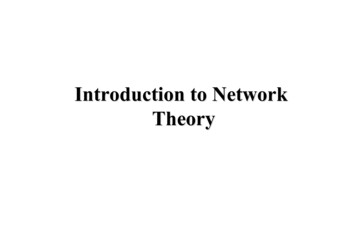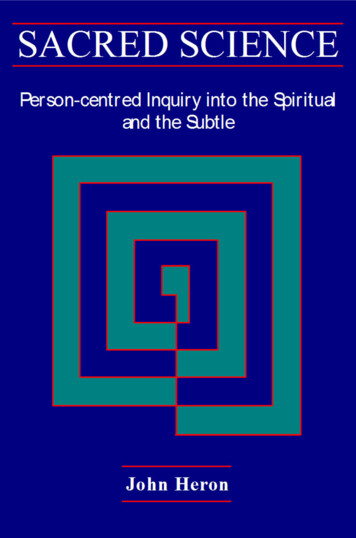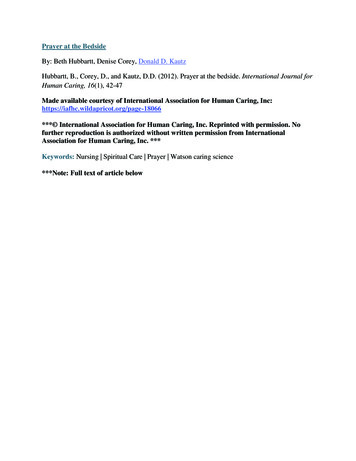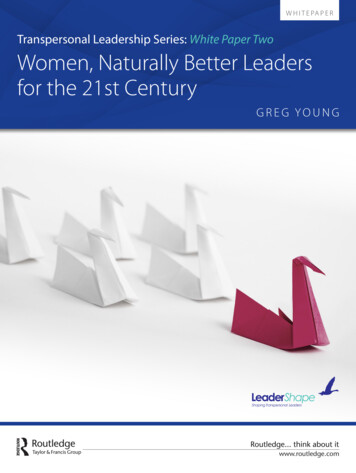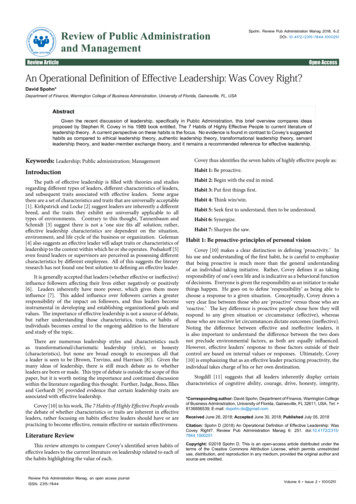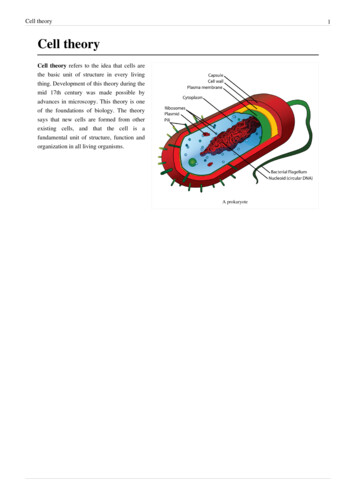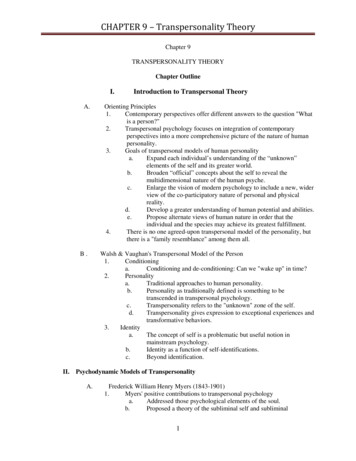
Transcription
CHAPTER 9 – Transpersonality TheoryChapter 9TRANSPERSONALITY THEORYChapter OutlineI.A.B.II.Introduction to Transpersonal TheoryOrienting Principles1.Contemporary perspectives offer different answers to the question "Whatis a person?"2.Transpersonal psychology focuses on integration of contemporaryperspectives into a more comprehensive picture of the nature of humanpersonality.3.Goals of transpersonal models of human personalitya.Expand each individual’s understanding of the “unknown”elements of the self and its greater world.b.Broaden “official” concepts about the self to reveal themultidimensional nature of the human psyche.c.Enlarge the vision of modern psychology to include a new, widerview of the co-participatory nature of personal and physicalreality.d.Develop a greater understanding of human potential and abilities.e.Propose alternate views of human nature in order that theindividual and the species may achieve its greatest fulfillment.4.There is no one agreed-upon transpersonal model of the personality, butthere is a "family resemblance" among them all.Walsh & Vaughan's Transpersonal Model of the Person1.Conditioninga.Conditioning and de-conditioning: Can we "wake up" in time?2.Personalitya.Traditional approaches to human personality.b.Personality as traditionally defined is something to betranscended in transpersonal psychology.c.Transpersonality refers to the "unknown" zone of the self.d.Transpersonality gives expression to exceptional experiences andtransformative behaviors.3.Identitya.The concept of self is a problematic but useful notion inmainstream psychology.b.Identity as a function of self-identifications.c.Beyond identification.Psychodynamic Models of TranspersonalityA.Frederick William Henry Myers (1843-1901)1.Myers' positive contributions to transpersonal psychologya.Addressed those psychological elements of the soul.b.Proposed a theory of the subliminal self and subliminal1
CHAPTER 9 – Transpersonality Theory2.B.consciousness.Psychology at a crossroadsa.In an age that gave us both Myers and Freud, psychologyfollowed Freud.b.Evolutionary theory found a friend in Freudianism.Sigmund Freud (1856-1939)1.Freud's positive contributions to transpersonal psychologya.View of mysticism as regressive infantile “oceanic feelings.”b.Use of evenly suspended attention as a therapeutic tool.c.Recognition of pleasure principle as underlying cause ofsuffering.d.Popularization of the personal subconscious in American culture.e.The importance of the psychological egof.The “lands of the psyche.”C.Carl Gustav Jung (1875-1961)1.Disagreements with Freud.2.Jung's positive contributions to transpersonal psychology.1. Opening the subject of the spiritual reality of the psyche to scientific inquiry.2. Described the objective nature of the human psyche.3. Outspoken critic of the materialistic bias of modern experimentalpsychology.4. Posited the existence of a collective or transpersonal unconscious.5. Openly espoused of the cause of parapsychological research.6. Made clear the expansive and flexible nature of the human ego7. Highlighted the supportive nature of subconscious portions of the psyche8. Explained the importance of the Self in the inner spiritual life of theindividual9. Clarified the role of symbols in psychic processes10. Elucidated the influence of shadow-like elements of the psyche11. Described the psychology and pathology of so-called “occult” phenomena12. Developing methods for investigating the spiritual life of the mind.D.Roberto Assagioli (1888-1974)1.What is Psychosynthesis?2.Key contributions of Psychosynthesis to transpersonal psychology.3.The structure of the human personality.a. Field of consciousnessb. Conscious self or phenomenal “I”c. Middle unconsciousd. Lower unconsciouse. Higher unconscious or superconsciousf. Collective unconsciousg. Higher (transpersonal) self4.Contacting the Transpersonal Selfa. Superconscious experiences may take many different forms.b. Superconscious experiences represent evidence about the nature of humanconsciousness.2
CHAPTER 9 – Transpersonality TheoryIII.Trait Theories of TranspersonalityA.Key Ideas in Trait Theories of Transpersonality1.What are traits?2.Psychological tests are designed to measure traits.3.Personality traits associated with transpersonal experience and behavior.a.Example study -- "Personality factors in the frequency of reportedspontaneous praeternatural experiences" (Nelson, 1989).b.People frightened of themselves.B.Gordon W. Allport (1897-1967)1.Traits of the healthy, mature personalitya. Extension of the self.b. Warm relating of self to othersc. Self-acceptance and self-affirmation.d. Realistic perception.e. Meaningful work and service.f. Self-insight.g. Unifying philosophy of life, especially religious sentiment.2.The Proprium3.The concept of self is unnecessary.C.D.Abhidhamma - An Eastern Trait Model of the Healthy Mature Personality1.Orienting principlesa.The principle of "No self" and the cause of suffering.b.The Noble Four Truths and Eightfold Path.2.The Healthy Personalitya.Healthy and unhealthy personality traits.3.Unhealthy personality traitsa.Delusion and false view.b.Shamelessness, remorselessness,egoism, perplexity.c.Agitation, worry, greed, avarice, envy,aversion, contraction, stupor.4.Healthy personality traitsa.Insight and Mindfulnessb.Modesty, discretion, rectitude, confidence.c.Nonattachment, non-aversion, impartiality, composure.d.Buoyancy, pliancy, efficiency, proficiency.5.The mentally healthy and mature personalitya.The Arahat: The ideal model of the healthy personality.Personality - East and West1.Healthy beyond belief?2.There are many paths to healthy mature personality functioning.3.Does exceptional well-being require an ego?3
CHAPTER 9 – Transpersonality TheoryV.IV.Humanistic-Phenomenological Transpersonality TheoriesA.Key ideas of humanistic-phenomenological personality theories.B.Carl Rogers (1902-1987)1.The fully-functioning person.C.Abraham H. Maslow (1908-1970)1.Basic healthy organismic and psychological functioning.2.Self-actualizing persons.3.Beyond self-actualization.Transpersonal Transpersonality TheoriesA.Humanistic psychology as transitional to a “higher” transpersonal psychology.B.Ken Wilber's Spectrum of Consciousness1.No boundary consciousness: Original state of unity-identity-whole.2.Primary boundary underlying all others: Me/Not-Me primary boundary.a.Boundary #1 - Persona/Shadow boundary.b.Boundary #2 - Mind/Body boundary.c.Boundary #3 - Body/Environment boundary.d."Transpersonal bands."e.Unity consciousness.C.Jane Roberts' (1929 - 1984) Aspect Psychology1.Focus personality2.Source Self3.Aspect Selves4.Basic Source Aspects5.Probable Selves and Probable Realities6.Reincarnational Selves4
CHAPTER 9 – Transpersonality TheoryChapter 9TRANSPERSONALITY THEORY AND ASSESSMENTLearning Objectives1. Explain why contemporary perspectives in psychology offer differing answers to the importantquestion, "What is a person?"2. Describe how a transpersonal approach to human personality differs from the approach taken by mostcontemporary perspectives in psychology.3. List and discuss the goals of transpersonal models of human personality.4. Explain why there is no one agreed-upon model of transpersonality, but how there is a "familyresemblance" among them all.5. Identify the four important dimensions essential to understanding the transpersonal nature of thehuman personality, according to Walsh & Vaughn's (1980) transpersonal model of the person.6. Explain why a de-conditioning process is regarded as an important part of transpersonalitydevelopment.7. Describe how personality is traditionally defined in most mainstream psychological theories.8. Name the factors identified by personality theorists that shape the personality's sense of consistencyand uniqueness over time.9. Identify the three aspects of personality that any comprehensive personality theory must address.10. Explain why personality as traditionally defined is something to be transcended in transpersonalpsychology.11. Describe how the Johari Window is relevant to understanding the transpersonal aspects or dimensionsof human personality.12. Describe the contribution that transpersonal psychology can make to psychology's currentunderstanding of human personality structure, dynamics, and development.13. Explain why the concept of self is a problematic but useful notion in mainstream psychology.14. Explain how personal identity is a function of self-identifications.15. Explain why dis-identification is regarded as an important part of transpersonality development.16. Identify and discuss the two key ideas that all psychodynamic theories of personality have incommon.17. Explain how ideas, emotions, and images are "action-events" from a psychodynamic point of view.18. Explain why F. W. H. Myers 1903 classic Human Personality and Its Survival of Bodily Death wassuch an important book for its time.19. Describe Myers's conception of the subliminal self and subliminal consciousness.20. Explain why mainstream psychology chose to ally itself with Sigmund Freud's ego-id-superegotheory of personality instead of Myers's subliminal self theory at the threshold of the nineteenth andtwentieth centuries.21. Identify and discuss Freud’s six main contributions to transpersonal personality theory.22. Describe the basic disagreements that existed between Freud and Carl Jung about the structure,dynamics, and development of human personality.23. Discuss three of Jung's most important contributions to the conceptual and methodologicaldevelopment of modern transpersonal psychology.24. Define the system of transpersonal psychology called Psychosynthesis and discuss how it differs fromother transpersonally-oriented approaches to human personality.25. Identify three key contributions of Psychosynthesis to psychology's understanding of the structure,states, function, and development of human personality.26. Draw the "egg diagram" depicting the seven basic regions that constitute the basic elements andconditions of the human psyche, according to Psychosynthesis.27. Describe the purpose and function of each of the seven basic regions that constitute the basicelements and conditions of the human psyche, according to Psychosynthesis.5
CHAPTER 9 – Transpersonality Theory28. Identify three ways in which superconscious experiences may manifest themselves in ordinary egoicstates of awareness and describe their effect on personality functioning.29. Summarize the implications of superconscious experiences for psychology's understanding of humanpersonality and what they represent about the potentials of consciousness evolution.30. Define the term trait and explain its use in personality theory.31. Identify the sorts of traits that have been identified to describe human personality as disclosed bypsychological measurement and assessment.32. Identify three personality traits that have been associated with transpersonal experience and behavior.33. Summary the research design and results of the study conducted by Nelson (1989) identifyingpersonality traits associated with the reported occurrence of spontaneous exceptional experiences andtransformative behaviors.34. Explain Nelson's (1989) observation that individuals who reported having fewer than fivetranspersonal experiences during their entire lives ("none" and "low" category of respondents) tendedto have personality traits related to control and constraint.35. Describe the capacities and personality characteristics of the healthy, mature personality, according totrait theorist Gordon Allport.36. Define the Proprium as the term is used by Gordon Allport and describe its eight elements orcomponents.37. Explain why Allport believes that the concept of self is unnecessary in personality psychology.38. Describe the nature of the self and the source of suffering according to the Eastern personality theoryAbhidhamma.39. Describe the four fundamental psychological principles of human personality functioning containedin the "Four Noble Truths" of classical Buddhism and tell how the Eight-fold path can help the humanpersonality overcome pain and suffering.40. Describe the structure and dynamics of human personality as depicted in Abhidhamma, especially thedynamic relationship that characterizes healthy and unhealthy personality traits.41. Describe the 14 traits, attitudes, or mental factors that give rise to unhealthy personality action, andexplain why they are considered "unhealthy."42. Describe the 14 traits, attitudes, or mental factors that give rise to healthy personality action, andexplain why they are considered "healthy."43. Explain how healthy personality traits may be developed and sustained in personality functioning.44. Describe the ideal model of the healthy mature personality represented by the Arahat in Abidhamma.45. Evaluate and judge the value of the Arahat as a model of the healthy mature person for Westernpersonality psychology.46. Evaluate and judge the value of the Buddhist personality theory Abidhamma for Western personalitypsychology.47. Discuss the role and function the ego structure in healthy personality functioning.48. Identify and discuss the key ideas of humanistic-phenomenological personality theories.49. Describe Carl Roger's conception of the "fully-functioning" person.50. Describe Abraham Maslow's conception of basically healthy organismic and psychologicalfunctioning.51. Describe Maslow's conception of a self-actualizing individual.52. Distinguish between the "merely healthy" self-actualizer and the "transcending self-actualizer."53. Summarize the important paradox that Maslow noted in regard to actualizing the self andtranscending the self.54. Describe the relationship between humanistic psychology and transpersonal psychology, historicallyspeaking.55. Identify and describe the five levels of identity in the development of human personality, according toKen Wilber's Spectrum of Consciousness model.56. Describe the nature of a person's original identity at birth, according to Wilber's Spectrum model.6
CHAPTER 9 – Transpersonality Theory57. Describe how the creation of identity as a separate self-sense occurs, according to Wilber's Spectrummodel.58. Identify the appropriate psychotherapies for healing the Me/Not-Me identity split.59. Describe the initial stage of personality development called the "shadow level," according to Wilber'sSpectrum model.60. Identify the appropriate psychotherapies for healing the Persona/Shadow identity split.61. Describe the stage of personality development called the "ego level," according to Wilber's Spectrummodel.62. Identify the appropriate psychotherapies for healing the Mind/Body identity split.63. Describe the stage of personality development called the "existential level," according to Wilber'sSpectrum model.64. Identify the appropriate psychotherapies for healing the Body/Environment identity split.65. Describe the process of identity development that occurs at the stage Wilber calls "the transpersonalbands."66. Describe the stage of personality development called the "level of Mind," according to Wilber'sSpectrum model.67. Discuss the origin, purpose, and definition of Aspect Psychology by Jane Roberts.68. Describe the nature and function of the aspect of human personality referred to as the "focuspersonality" in Aspect Psychology.69. Describe the nature and function of the ego and the reasoning mind70. Describe the nature and function of the aspect of human personality referred to as the "Source Self,"in Aspect Psychology.71. Describe the nature and function of the aspects of human personality referred to as "Aspect Selves,"in Aspect Psychology.72. Describe the nature and function of the aspect of human personality referred to as "Basic SourceAspects," in Aspect Psychology.73. Discuss the role that probable actions and probable events play as a source for physical experienceand as a framework for personality development, according to Aspect Psychology.74. Discuss the role that reincarnational selves play as a part of our personality structure, according toAspect Psychology.75. Describe the notion of simultaneous time and explain why we perceive time as a series of moments,according to Aspect Psychology.76. Evaluate and judge the value of the empirical and clinical evidence suggestive of reincarnation.7
CHAPTER 9 – Transpersonality TheoryChapter 9 SummaryTraditional psychology defines personality as a set of relatively enduring structures and dynamics,behaviors and traits, social dispositions and cognitive characteristics, meaning and purpose that givesconsistency to a person’s experience and behavior and that make’s the individual unique. Psychodynamicapproaches (Freud, Jung) emphasize the role of subconscious structures and dynamics that affectpersonality functioning. Trait approaches focus on the stable qualities, attributes and traits that areobserved by others or reported by the individual as characterizing their unique experience and behavior.The humanistic-phenomenological approach views inner-directness toward ideal growth and fulfillmentas the basic motivating force of human personality. Transpersonality theory addresses what can beconsidered to be the “unknown” reality of personality functioning. Using the metaphor of the JohariWindow of social psychology (Luft, 1970), this is that portion of the personality (known to self, known toothers, unknown to self, unknown to others) which is both unknown to self and unknown to others – theunknown zone - that contains the latent abilities, capacities, and potentials of the personality.Transpersonal psychology gives voice to notions such as “soul” “paranormal abilities,” and those extradimensional aspects of human personality that point to an alternate version of human personality forpsychological science to explore. Self-knowledge (“Know Thyself”) is a process of self-discovery and ofbecoming, not only of becoming more familiar with other portions of the self, but also of becoming moreoneself - the more that one discovers, the more one is. Just as abilities grow as they are used, so does theself grow as it is used in the process self-discovery. To discover the unknown reality of one's selfrequires that one travels inward within one's own psyche along invisible pathways just as one journeysoutward within physical reality along visible ones.Transpersonal models of personality that emphasize a psychodynamic approach, such as F. W. H. Myers,Carl Jung, and Roberto Assagioli share the common assumption of the existence of a subconsciousdimension of human personality that energizes, supports, sustains conscious ego-directed personalityaction. Trait-oriented theories, especially those of the Asian East, view personality as being simply acollection of traits and habits descriptive of behavior with no underlying enduring Self. Personality fromthe humanistic-phenomenological viewpoint are represented by the personality theories of Carl Rogersand Abraham Maslow. Transpersonal psychologies of personality, such as Ken Wilber's Spectrum ofConsciousness and Jane Roberts' Aspect Psychology, offer a different view human personality than thatpresented in traditional psychological science. While all transpersonal models of personality differ inwhat they emphasize, there is a family resemblance among them in the notion of an underlying unity thatbinds all individuality to a shared inner source that is transpersonal (beyond ego).8
CHAPTER 9 – Transpersonality TheoryCHAPTER 9TRANSPERSONALITY THEORYIntroduction to Transpersonality TheoryOrienting PrinciplesRecognition that different contemporary perspectives offer different answers to the question "What is aperson?" Current perspectives in psychology offer differing answers to the important question, "What isa person?" The biological perspective will look to how the body and brain determine the way a personfeels, thinks, and acts, and highlight how much our genes influence individual differences in personalitytraits. The psychodynamic perspective will view our personality as a product of unconscious drives andconflicts. Trait theorists will describe personality as consisting of traits that refer to internal dispositionsthat motivate observable personality action. Cognitive psychology will spotlight the role of ideas, beliefs,and expectations in personality functioning. Social-cultural perspective will draw attention to howpersonality is shaped by culture and social situations.Transpersonal psychology focuses on integration of contemporary perspectives into a morecomprehensive picture of the multidimensional nature of human personality. The transpersonalperspective does not negate any of these views, but focuses on their integration into a morecomprehensive, multidimensional model of human personality that situates the person in a greatercontext, with greater origins, motives, purposes, and meanings than traditionally assigned to it. Althougheach of psychology's traditional perspectives emphasize different aspects of the person, and may give theimpression of presenting fundamentally dissimilar pictures of personality, they all assume and presupposea four-dimensional model of human nature situation in time and space. Transpersonal psychology buildsupon and extends other models by proposing that a multidimensional human personality existing within areality that is itself multidimensional, behind and beyond yet within the material reality perceived by thephysical senses and that provides the context for the ego-oriented personality with which most peopleidentify.Goals of transpersonal models of human personality. By encouraging us to explore the hidden contoursof our own consciousness and the role that consciousness may place in the creation of personal reality,transpersonal psychology proposes new models of human personality. Transpersonal models ofpersonality presented in this chapter in one way or another seek to (a) expand each individual’sunderstanding of the “unknown” elements of the self and its greater world, (b) broaden “official” conceptsabout the self to reveal the multidimensional nature of the human psyche, (c) enlarge the vision of modernpsychology to include a new, wider view of the co-participatory nature of personal and physical reality,(d) develop a greater understanding of human potential and abilities, and (e) propose alternate views ofhuman nature in order that the individual and the species may achieve its greatest fulfillment. Whilemainstream psychology holds limited concepts of the person, it will not have any true awareness of themany abilities that lie within each individual or be able to teach people how to practically take advantageof those abilities that are ours. Until psychologists of all persuasions recognize and acknowledge themultidimensional reality of human personality, psychology will not have any complete understanding ofthose great forces within yet beyond human nature that gave birth to human life, mind, and consciousness.There is no one agreed-upon transpersonal model of the personality, but there is a "familyresemblance among them all. In this chapter, the substantial contributions of psychodynamic theories ofF. W. H. Myers, Sigmund Freud, Carl Jung, and Roberto Assagioli to transpersonal theory are examinedfirst. The trait personality theories of Gordon Allport and Asian East personality theories follow.Personality from a biological perspective is presented in Stanislav Grof’s view of personality action“beyond the brain”. Personality from the representational or phenomenological viewpoint of Abraham9
CHAPTER 9 – Transpersonality TheoryMaslow and Ken Wilber are examined. To conclude our discussion of transpersonality, the transpersonalmodel of Jane Roberts and her theory called Aspect Psychology is presented. The reason there are manydifferent theories of transpersonality is the same reason why there are so many theories of ordinarypersonality in mainstream psychology -- each psychological perspective and every personality theoriststarts with different assumptions, uses different assessment methods, and focuses on different aspects ofpersonality structure, personality dynamics, and personality development in their attempt to understandthe factors that shape the individual’s sense of consistency and uniqueness. It is important to note at theoutset that there is no one transpersonal model of human personality.Disagreements among transpersonalists are the norm rather than the exception. And thesedivergences are not merely about minor theoretical issues, but often about the centralphilosophical and metaphysical foundations of the field, for example, the understanding oftranspersonal phenomena, the meaning of spirituality, or the very nature of reality. (Ferrer, 2002,p. 7)Nevertheless, there is a “family resemblance” among the various transpersonal models (Matlin, 2005, pp.254-256). Whereas no single feature or proposition or principle is shared by all theories in transpersonalpsychology, each theory has at least one principle or proposition in common with some othertranspersonal personality theory. For example, the Buddhist-oriented transpersonal theory ofAbhidhamma does not grant the existence of a substantial self or, but such a self or soul-aspect isacknowledged by the Western-oriented theory Roberto Assagioli's Psychosynthesis. Yet both theoriesrecognize the existence of a unitary dimension in which all of Being is connected and interrelated into asingle-integrated whole. In the Western version of this all-encompassing unity, individual and uniquenessof consciousness remains intact and is inviolate, whereas Eastern-versions of this wholeness swallows upindividuality and considers it illusory. These are important point of disagreement that are not to beoverlooked in the final analyses of our understanding of the nature of human personality (e.g., do wesurvive bodily death intact or do we get swallowed up in an all-inclusive nirvana?). The point here is thatthe notion of an underlying unity that binds all individuality is a shared feature of all transpersonalpersonality theories that connects the theories together despite their differences. There is a great deal ofoverlap among these theories and some important differences. The unique understanding each theorycontributes to our understanding of human personality action, however, will be emphasized throughout.Walsh & Vaughan's Transpersonal Model of the PersonSeveral key aspects of the transpersonal models of personality discussed in this chapter can be understoodby a brief examination of the classic transpersonality theory of Walsh and Vaughan (1980) whichrepresents "the basic tenets of a transpersonal model" of the person (p. 54). Walsh and Vaughan's modelidentifies four important dimensions essential to understanding the transpersonal nature of the humanpersonality: (a) consciousness, (b) conditioning, (c) personality, and (d) identity. Consciousness wasexamined in chapter 4 ("States of Consciousness"). Let us look briefly at the remaining threedimensions.ConditioningConditioning and de-conditioning: Can we "wake up" in time? Conditioning is regarded as afundamental process of learning that is defined as any relatively permanent change in behavior as a resultof experience. Conditioning is based upon spontaneous associative processes whereby two stimuli or astimulus and a response become joined together in experience. Classical or Pavlovian respondentconditioning is regarded as an nonconscious, involuntary, automatic form of associating two stimulitogether whereas Skinnerian operant conditioning is viewed as a conscious, voluntary, deliberative formof associating a response with its consequence such that the behavior tends to be repeated (reinforced) or10
CHAPTER 9 – Transpersonality Theorydiminished in frequency (punished). Habits are a common example of conditioning at work. Walsh andVaughan (1980) state thatthe transpersonal perspective holds that people are more vastly ensnared and trapped in theirconditioning than they appreciate, but. . . freedom from this conditioning is possible. The aim oftranspersonal psychotherapy is essentially the extraction of awareness from this conditionedtyranny of the mind. (p. 55)Transpersonal psychologist Charles Tart (1987, p. xi) refers to this de-conditioning process as "wakingup" from the "consensus trance" induced in us by our culture. Therapist Stephen Wolinski (1991, p. 1)writes about "trances people live by" and the task of de-hypnotizing individuals out of their self-inducedtrance states which result in the self-created problems of everyday life. Transpersonal scholar RalphMetzner (1986, p. ix) calls the process of extracting waking consciousness from this conditioning as"opening to inner light." Psychiatrist Roger Walsh (1984, p. xvi) states that freedom from "tranquilizationby the trivial" fostered by the psychological and social forces that keep us "unconscious" to the problemsof overpopulation, poverty, malnutrition, pollution, and disease is not only possible but essential to"staying alive" and human survival. Transpersonal writer Peter Russell (1998, p. 87) argues that "wakingup in time" will depend on a spiritual renaissance and finding inner peace in times of accelerating change.Transpersonal author Willis Harman (1984, p. xvii; 1998, p. xxiii) states that a "global mind change" and"liberating the unconscious for breakthrough insights" are required to re-program the unconscious andleap beyond our previous habitual ways of resolving our difficulties. The Eastern personality theory ofAbhidhamma discussed in this chapter identifies numerous unhealthy mental factors that contribute tovarious forms that conditioning may take (e.g., attachment to objects, people, self-image, habits,psychological processes, social roles, personal problems, ideas and beliefs). Two main forms ofmeditation practice -- concentration and mindfulness -- have d
24. Define the system of transpersonal psychology called Psychosynthesis and discuss how it differs from other transpersonally-oriented approaches to human personality. 25. Identify three key contributions of Psychosynthesis to psychology's understanding of the structure, states, function, and develo




